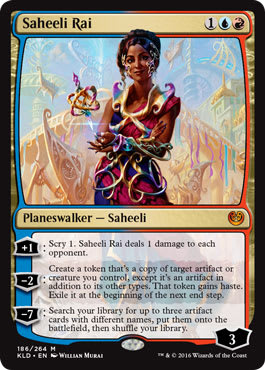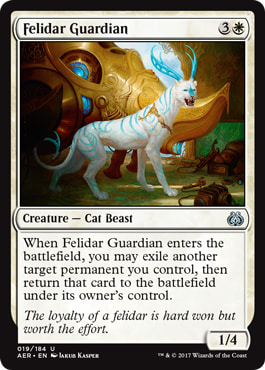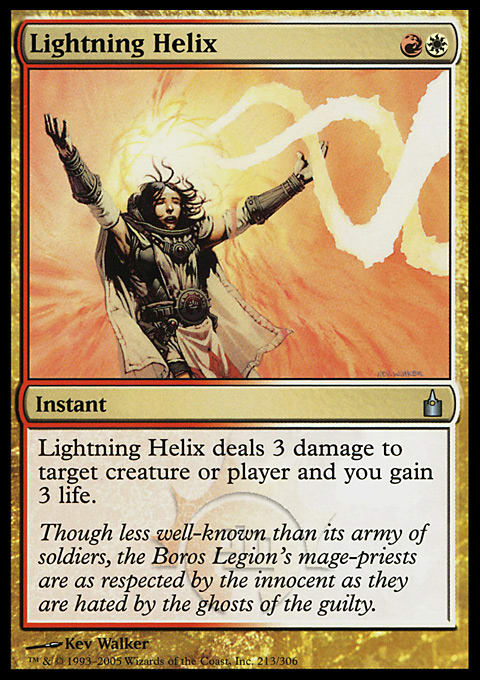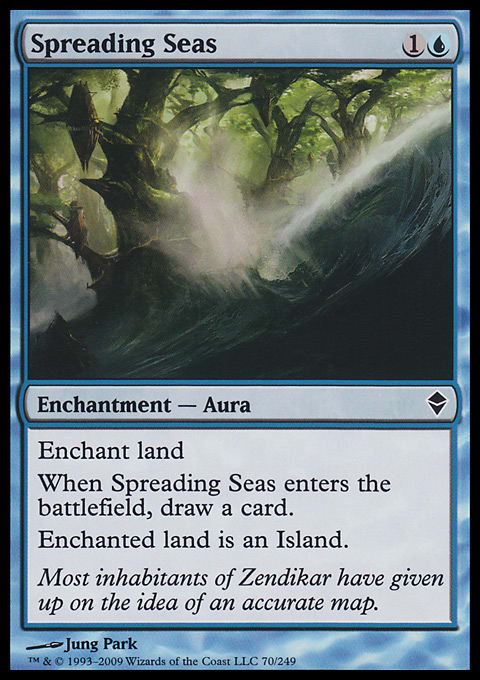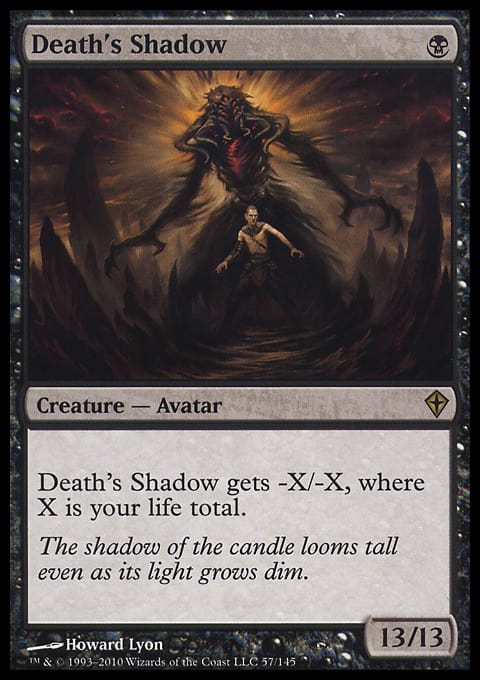No, it’s not getting unbanned. At least, not that I’m aware of. Don’t get your hopes up, folks who’ve been stockpiling cheap copies of the Modern Masters 2015 rare in the hopes that Wizards has a sudden change of heart. However, tucked away in the Top 32 lists of a number of Modern tournaments recently, a strange and wonderful ex-Standard deck seems to be showing signs of life. Part of the beauty of Modern is that oppressively strong Standard decks can “pick on others their own size”, so to speak. Faeries, Jund, Dredge, Affinity, Delver, Hexproof, Tron, all of them can coexist together in a sort of detente between otherwise dominant strategies. It comes as no surprise, then, that the formerly oppressive Felidar Guardian/Saheeli Rai combo that necessitated an emergency Standard ban has now found itself a niche in Modern. It’s not quite Splinter Twin, it’s not quite control, but Jeskai Saheeli is quietly putting up enough results to merit attention from savvy deck-builders. And what’s not to like? The deck has much of the appeal of Jeskai Control decks that never seem to quite finish the job in Modern tournaments with a huge “free win percentage” equity boost, not to mention the fun that comes along with surprising opponents with an infinite combo. Let’s start by looking at two lists: Oren Lagziel’s recent Top 32 list from the Modern Open in Roanoke this past weekend, and Paulo Vitor Damo da Rosa’s outdated Jeskai Splinter Twin list from a Modern long gone, back two years ago before Twin got banned.
Jeskai Saheeli ? Modern | Oren Lagziel
- Creatures (11)
- 1 Pia and Kiran Nalaar
- 1 Vendilion Clique
- 2 Wall of Omens
- 3 Snapcaster Mage
- 4 Felidar Guardian
- Planeswalkers (5)
- 1 Jace, Architect of Thought
- 4 Saheeli Rai
- Instants (14)
- 2 Lightning Helix
- 4 Lightning Bolt
- 4 Path to Exile
- 4 Remand
- Sorceries (8)
- 4 Serum Visions
- 4 Spreading Seas
- Lands (22)
- 1 Mountain
- 1 Plains
- 2 Island
- 1 Arid Mesa
- 1 Sacred Foundry
- 1 Sulfur Falls
- 2 Celestial Colonnade
- 2 Hallowed Fountain
- 2 Spirebluff Canal
- 2 Steam Vents
- 3 Scalding Tarn
- 4 Flooded Strand
- Sideboard (15)
- 1 Grafdigger's Cage
- 2 Rest in Peace
- 1 Stony Silence
- 1 Blessed Alliance
- 2 Ceremonious Rejection
- 1 Dispel
- 1 Wear
- 1 Vendilion Clique
- 1 Ajani Vengeant
- 2 Anger of the Gods
- 1 Supreme Verdict
- 1 Timely Reinforcements
Jeskai Twin ? Modern | Paulo Vitor Damo da Rosa
- Creatures (16)
- 2 Kiki-Jiki, Mirror Breaker
- 3 Restoration Angel
- 3 Wall of Omens
- 4 Deceiver Exarch
- 4 Snapcaster Mage
- Instants (13)
- 1 Dispel
- 1 Spell Snare
- 3 Path to Exile
- 4 Lightning Bolt
- 4 Remand
- Sorceries (4)
- 4 Serum Visions
- Enchantments (3)
- 3 Splinter Twin
- Lands (24)
- 1 Mountain
- 1 Plains
- 2 Island
- 1 Cascade Bluffs
- 1 Desolate Lighthouse
- 1 Hallowed Fountain
- 1 Sacred Foundry
- 1 Sulfur Falls
- 2 Flooded Strand
- 2 Steam Vents
- 3 Arid Mesa
- 4 Celestial Colonnade
- 4 Scalding Tarn
- Sideboard (15)
- 2 Spellskite
- 1 Negate
- 3 Timely Reinforcements
- 2 Keranos, God of Storms
- 1 Vendilion Clique
- 2 Supreme Verdict
- 2 Wear // Tear
- 2 Dispel
Notice a few similarities? Both of these decks have the distinct privilege of playing an entire game while threatening the opponent with a kill out of nowhere, should they tap out. Jeskai Splinter Twin could cast an end-step Deceiver Exarch and untap to slam the Twin for the win, while Saheeli Rai combo can do the whole combo in one turn with only six lands available. They merely need to cast the Felidar Guardian, blink a land back in, and use that one and the remaining two to cast a Saheeli Rai and fire off infinite cats. Both decks also make great use of a ton of value cantrip cards; Wall of Omens and Spreading Seas both do stellar work at impeding various opposing game plans while churning through the deck for the two combo pieces. Remand ties the room together for both of these strategies as well, as nothing screams “tempo-combo” like the cantripping counterspell that often works like a Time Walk. Pro players Jason Chung and Anthony Lee were even willing to give this deck a shot back at GP Brisbane earlier this year, placing it firmly in the camp of “possibly overlooked gems” that litter the Modern landscape. And with this kind of pedigree, it would be criminal not to give the deck another look. Indeed, I spoke with Oren at the recent SCG tournament, and his enthusiasm for the deck was infectious. It’s not hard to see why, looking at the many sweet things one can do with a value-oriented combo-control deck.
Now, what differs between the Splinter Twin decks of yore and the Jeskai Saheeli decks rising now? Three key factors:
1: Splinter Twin never had to deal with Grixis Death’s Shadow
Now is not the time to mince words. Were Grixis Shadow a played deck while Splinter Twin combo was still around, it would have mopped the floor with the Twin deck. Repeated Thoughtseizes, Fatal Pushes, Stubborn Denials and un-Bolt-able threats combine to represent a tremendous strategic advantage that may have pushed the Twin deck down to acceptable levels. In fact, though Wizards is highly unlikely to do this, Splinter Twin is theoretically safer to unban in an environment where the Jund-style decks of the format are both faster and more disruptive than they were before. Despite several key differences, Jeskai Saheeli is at its core a two-card combo deck vulnerable to a variety of interaction points, all of which Grixis Shadow punishes. Therefore, if Jeskai Saheeli is to be successful, it will need to have a plan for Grixis Death's Shadow. That plan might be sideboarding a pile of Rest in Peaces or creatures with Protection from Black, but there needs to be some sort of plan to ensure victory in this tricky matchup.
2: Splinter Twin was a flash deck; Saheeli is a sorcery-speed deck
Unlike Splinter Twin, Saheeli Combo can tap out on turn five for a threat or an answer, allow the opponent to tap out for a response, and then calmly execute the combo in a single turn. Compare this to Splinter Twin, which needed to keep three lands untapped during the opponent’s turn to represent the threat of a combo. Twin Combo therefore veered more toward countermagic, instant-speed threats, and a flash-based gameplan. Saheeli Combo can happily play fewer permission spells, more sorcery-speed disruption (such as cards like Supreme Verdict, Anger of the Gods, and Spreading Seas) and function just as well as ever. The repercussions of this playstyle shift can and should change how the two decks are built. Incidentally, Felidar Guardian and Saheeli Rai herself are slightly more valuable individually compared to Deceiver Exarch and Splinter Twin, as Saheeli can filter draws, copy Snapcaster Mage, or chip shot a few points of damage, while Felidar Guardian can draw a card by flickering a Spreading Seas, Snapcaster Mage or Wall of Omens. This actually makes the secondary gameplan significantly more potent than it was with Splinter Twin, as Saheeli presents a legitimate threat in the way that Deceiver Exarch didn’t, and she’s remarkably easy to protect with the massive pile of cheap removal in the Jeskai color combination. Imagine a sequence such as “Lightning Bolt your creature, Lightning Helix your creature, cast Saheeli Rai on an empty board.” How is any moderately aggressive deck beating that? Even against Death's Shadow, a pile of Path to Exiles can mean a topdecked Saheeli Rai puts immense pressure on the opponent to find a threat or lose quickly.
3: Opposing playstyles have changed
Two competing factors that affect players who might pick up Saheeli combo are at play here. The first is the beneficial fact that Modern players have stopped needing to think about how to play against a deck that might kill at any time, making them worse (for the time being) at figuring out when to play cagey and when to play aggressively against this style of deck. If Jeskai Saheeli comes back into the metagame, opponents will doubtless pick up on those old habits, and put a tiny (but noticeable) dent in Saheeli players’ win percentages. The second, unfortunately, is that many reasonably skilled players have learned to default to a more aggressive, “If they have it, they have it” play style in these false tempo matchups in general, taking the best tool out of the Jeskai Saheeli player’s hands and turning the games more into all-in shove-fests. Frequently, in the past, the false tempo gained from opponents playing with two or three lands untapped the whole game allows a combo-control player to eke out advantages turn after turn and win a game without ever attempting to execute the combo. If the opponent taps out every turn to try to cut the clock as low as possible in the face of a potential instant loss to the infinite combo, they are essentially putting the Saheeli player to the test. Fear of the combo wins more games than the combo itself, and a fearless opponent is a false tempo player’s worst nightmare. That said, the Saheeli deck does dig reasonably well, and can play a flawless control game with a high percentage of its opening hands (as a benefit of playing passable control cards like Spreading Seas, 1/4 cantripping blockers, and infinite removal) so there’s less stress to find the combo quickly when compared to the Splinter Twin deck.
With all of this in mind, this updated list may have a bit more firepower and clean sideboard plans, both of which are great places to start with testing.
Updated Jeskai Saheeli ? Modern | Ben Friedman
- Creatures (10)
- 1 Pia and Kiran Nalaar
- 1 Torrential Gearhulk
- 4 Felidar Guardian
- 4 Snapcaster Mage
- Planeswalkers (4)
- 4 Saheeli Rai
- Instants (14)
- 1 Dispel
- 1 Lightning Helix
- 4 Lightning Bolt
- 4 Path to Exile
- 4 Remand
- Sorceries (5)
- 1 Supreme Verdict
- 4 Serum Visions
- Enchantments (4)
- 4 Spreading Seas
- Lands (23)
- 1 Mountain
- 1 Plains
- 2 Island
- 1 Arid Mesa
- 1 Sacred Foundry
- 1 Sulfur Falls
- 2 Hallowed Fountain
- 2 Spirebluff Canal
- 2 Steam Vents
- 3 Celestial Colonnade
- 3 Scalding Tarn
- 4 Flooded Strand
- Sideboard (15)
- 3 Rest in Peace
- 2 Stony Silence
- 3 Blessed Alliance
- 1 Dispel
- 2 Negate
- 1 Wear // Tear
- 1 Anger of the Gods
- 1 Supreme Verdict
- 1 Jace, Architect of Thought
This list eschews Wall of Omens, which is particularly weak in a format where the premier aggressive deck involves 4/5s, 5/5s, and 10/10s for a single black mana. Instead, there are a ton of good cards against Death's Shadow, Valakut, Tron, Dredge, and Counters Company, with reasonable sideboard plans against other control decks (of which there were a lot in the recent SCG). It cuts Ceremonious Rejection, which was only ever okay against Affinity and Eldrazi Tron, for an additional Stony Silence, and it’s possible that the third Rest in Peace should become a third Stony Silence for those matchups in particular. Shutting down Expedition Map, Mind Stone, Walking Ballista and the like is a big game!
The Negates in the sideboard are there to better compete with various other combo and control decks, as Valakut-based combo, Ad Nauseam, Storm, Jeskai and ![]()
![]() Control all show up in varying degrees at many Modern tournaments. Negate is by far the weakest card in the sideboard, though, as it competes on mana cost with Remand and is significantly worse than Dispel at protecting the Saheeli combo against opposing control decks. As a hard counter, though, they are the best in the business, but a third Dispel or a Vendilion Clique might be reasonable to include over them. Vendilion Clique is obviously a flexible card, for sure, but it’s a bit weak at actually providing an answer to any of the powerful threats that comprise most Modern decks. If a sideboard card isn’t powerfully impacting a given matchup or moderately impacting multiple, it doesn’t deserve the spot, and Vendilion Clique is somewhat low-impact. However, it may be the card for the job, and as such, it is the vaunted “sixteenth” sideboard card that would make it were one card to be cut.
Control all show up in varying degrees at many Modern tournaments. Negate is by far the weakest card in the sideboard, though, as it competes on mana cost with Remand and is significantly worse than Dispel at protecting the Saheeli combo against opposing control decks. As a hard counter, though, they are the best in the business, but a third Dispel or a Vendilion Clique might be reasonable to include over them. Vendilion Clique is obviously a flexible card, for sure, but it’s a bit weak at actually providing an answer to any of the powerful threats that comprise most Modern decks. If a sideboard card isn’t powerfully impacting a given matchup or moderately impacting multiple, it doesn’t deserve the spot, and Vendilion Clique is somewhat low-impact. However, it may be the card for the job, and as such, it is the vaunted “sixteenth” sideboard card that would make it were one card to be cut.
So, in a format defined by Death's Shadow, why play Jeskai Saheeli? The deck is powerful, it’s as close to Splinter Twin as we’re likely to get in this Modern format, and it sports a robust midrange value plan alongside the free win equity caused by having a turn-four combo available against a number of non-interactive strategies. It’s stronger than Twin would have been against Grixis Shadow, and it has the powerful White sideboard cards to shore up a number of tough matchups. Give the updated list a shot, and see if infinite cats don’t solve your Modern woes!













